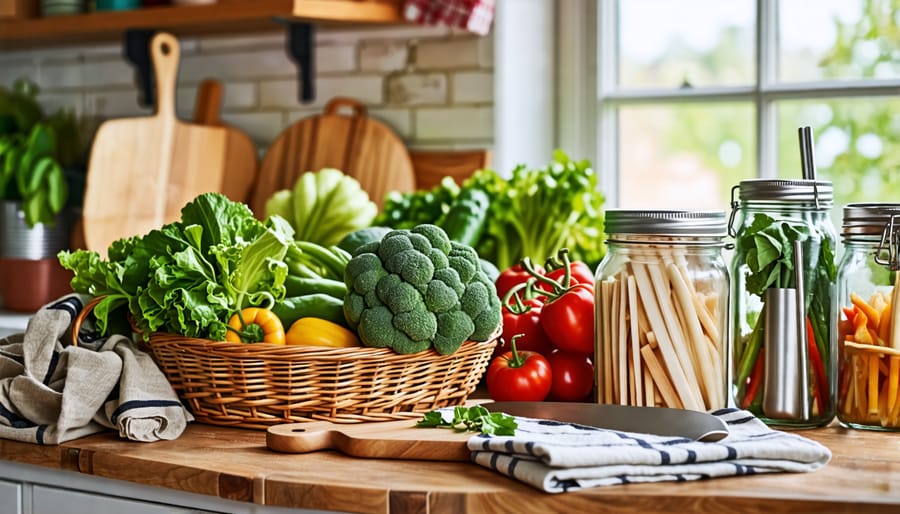8 Waste-Busting Habits: Simple Swaps for a Greener Farmhouse

Swap single-use plastic bags for reusable produce bags, shopping totes, and containers to significantly cut household waste. Compost food scraps and yard waste to reduce your trash output while nourishing your garden soil, embracing the benefits of reducing and recycling. Opt for durable, long-lasting items like stainless steel straws, glass jars, and cloth napkins over disposable alternatives. Repair, repurpose, or donate items before considering throwing them away, extending their useful life and keeping them out of landfills.
Composting Food Scraps

What to Compost
When it comes to composting food scraps from your farmhouse kitchen, the possibilities are endless! Toss in those banana peels, apple cores, and melon rinds – they’ll break down beautifully. Coffee grounds and tea bags are also fantastic additions, providing valuable nitrogen to the mix. Don’t forget about eggshells – crushed up, they’re a great source of calcium for your garden. Veggie scraps like carrot tops, potato peels, and onion skins are perfect for the compost bin too. Even plain cooked pasta or rice can join the party! Just steer clear of meat, dairy, and oily foods, as they can attract pests. With a little know-how and a designated compost area, you’ll be amazed at how much kitchen waste you can transform into rich, nourishing soil for your beautiful farmhouse garden. It’s a simple, eco-friendly practice that connects us to the earth and the natural cycle of life.
Composting Tips
To maintain a thriving compost pile, aim for a balance of green and brown materials. Greens, like fresh grass clippings, kitchen scraps, and coffee grounds, provide nitrogen. Browns, such as dry leaves, straw, and shredded paper, contribute carbon. Strive for a ratio of about 3 parts brown to 1 part green. Keep your compost pile moist but not soggy; it should feel like a wrung-out sponge. Turn the pile every few weeks to aerate it and distribute moisture evenly. You can also add a shovelful of finished compost or garden soil to introduce beneficial microorganisms that speed up decomposition. Avoid adding meat, dairy, oily foods, diseased plants, or pet waste to your compost. With a little patience and care, you’ll soon have nutrient-rich compost to nourish your garden and reduce waste sent to landfills. If you’re interested in more detailed guidance on composting, check out how to make your very own compost.
Repurposing Old Clothes and Linens
Breathe new life into your old clothes and linens by repurposing them into useful items around the farmhouse. Worn-out t-shirts and towels make excellent cleaning rags – simply cut them into squares and keep a stack handy for wiping up spills or dusting furniture. Faded flannel shirts can be transformed into cozy quilts, perfect for snuggling up on chilly evenings. Gather your favorite pieces and stitch them together with love, creating a cherished family heirloom.
Don’t toss those tattered jeans just yet! Cut them into strips and use them as sturdy garden ties for supporting climbing plants like tomatoes or pole beans. Denim is durable and weather-resistant, making it an ideal material for outdoor use. Old pillowcases can be repurposed into produce bags for harvesting fresh veggies from your garden or storing homegrown potatoes and onions in the pantry.
Get creative with your upcycling projects – the possibilities are endless! Transform a vintage dress into a charming apron, or sew together colorful fabric scraps to make unique curtains for your farmhouse windows. By giving your old clothes and linens a second chance, you not only reduce waste but also add a touch of character and nostalgia to your home. Embrace the thrifty spirit of our ancestors and find joy in the simple act of repurposing.

Donating and Selling Used Items
One simple yet impactful way to reduce waste is by finding new homes for gently used items you no longer need. Before tossing things in the trash, consider whether someone else might find value in them. Donating to local charities not only keeps these items out of landfills but also supports those in need within your community. Many organizations, such as Goodwill or The Salvation Army, accept a wide range of items from clothing and household goods to furniture and electronics.
If you have items of value that you’d prefer to sell, online marketplaces like Facebook Marketplace, Craigslist, or eBay make it easy to connect with buyers. Selling used items extends their lifespan and puts a little extra cash in your pocket. Another option is hosting a good old-fashioned yard sale – it’s a great way to meet neighbors and clear out clutter at the same time.
When donating or selling, be sure to assess the condition of each item honestly. While minor wear and tear is generally acceptable, aim to pass along things that are still functional and usable. With a little effort, you can give your unwanted belongings a second life while reducing unnecessary waste.
Reducing Paper Waste
In our farmhouse, we’ve found countless ways to cut down on paper waste and embrace more sustainable habits. One of the simplest swaps we made was switching from disposable paper napkins to reusable cloth napkins. Not only do they add a touch of charm to our dinner table, but they also significantly reduce the amount of paper we use and toss out daily. We keep a basket of clean napkins readily available and toss the used ones in with our regular laundry.
Another game-changer for us has been utilizing digital tools for organizing and note-taking. Instead of relying on countless sticky notes and scraps of paper, we now use apps on our phones and tablets to keep track of grocery lists, to-do lists, and important reminders. It’s amazing how much paper clutter we’ve eliminated by going digital!
When it comes to our home office, we’ve implemented a few key strategies to minimize paper waste. We opt for double-sided printing whenever possible and have set our printer’s default settings to draft mode, which uses less ink. Additionally, we keep a scrap paper tray next to the printer for those times when we need to jot something down quickly or print a draft. Any paper that’s still blank on one side gets a second life in the scrap tray.
In the kitchen, we’ve replaced disposable paper towels with reusable cloth towels and rags. We keep a stack of clean towels on hand for wiping up spills, drying dishes, and cleaning surfaces. When they get dirty, we simply toss them in the wash with our other linens. This simple change has drastically reduced our paper towel consumption and saved us money in the long run.
As we continue to find ways to reduce waste on our farmhouse, we’ve discovered that every small change adds up. By being mindful of our paper usage and seeking out reusable alternatives, we’ve created a more sustainable home that aligns with our values. And of course, these efforts go hand-in-hand with our other eco-friendly practices, like implementing water conservation tips in our garden and around the farm.

Mindful Shopping Habits
In the hustle and bustle of daily life, it’s easy to get caught up in the convenience of quick purchases without considering their environmental impact. However, by cultivating mindful shopping habits, we can significantly reduce waste and embrace a more sustainable lifestyle. One effective strategy is to buy in bulk whenever possible. Not only does this cut down on packaging waste, but it also often saves money in the long run. When shopping for staples like grains, nuts, and dried fruits, opt for the larger quantities and store them in reusable containers at home.
Another way to minimize waste is by choosing items with minimal packaging. Look for products that use recyclable or biodegradable materials, or better yet, those that come in no packaging at all. Farmers’ markets and local produce stands are great places to find fresh, unpackaged fruits and vegetables. You can also bring your own reusable bags and containers to fill up on bulk items at many grocery stores.
Don’t forget the power of secondhand shopping! Thrift stores, consignment shops, and online marketplaces are treasure troves of gently used items that deserve a second life. From clothing and furniture to kitchen gadgets and home decor, buying secondhand not only reduces waste but also supports local charities and keeps perfectly good items out of landfills.
When it comes to reducing waste, small changes in our shopping habits can make a big difference. By being intentional about our purchases, we can create a more sustainable home and set a positive example for our families and communities. And while we’re at it, why not take it a step further and explore other eco-friendly practices like composting, upcycling, and rainwater harvesting? Every mindful choice brings us one step closer to a greener, more beautiful world.
Conclusion
In conclusion, the seemingly small changes we make in our daily lives can have a profound impact on the environment and future generations. By embracing waste reduction practices, we not only lighten our ecological footprint but also cultivate a mindset of mindfulness and gratitude. Whether it’s composting kitchen scraps, repurposing old fabric into cleaning cloths, or simply being more intentional about our purchases, every action counts.
As we’ve seen through these examples, living sustainably doesn’t have to be complicated or expensive. It’s about making conscious choices that align with our values and goals. By starting with one small change, like bringing reusable bags to the grocery store or switching to cloth napkins, we can gradually build momentum and inspire others to do the same.
Imagine the collective impact if every household adopted just a few of these waste reduction practices. We could significantly reduce the amount of trash sent to landfills, conserve precious resources, and create a cleaner, healthier planet for all. So let’s embrace the journey towards a more sustainable lifestyle, one small step at a time. Together, we can make a world of difference.
